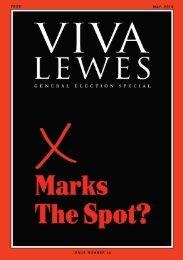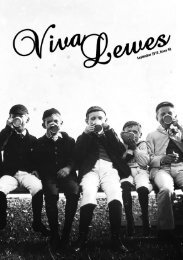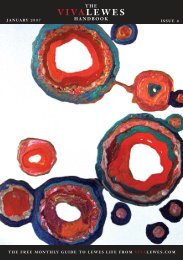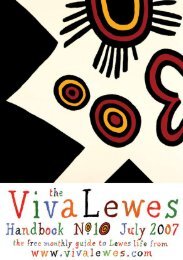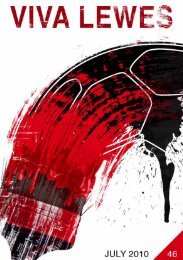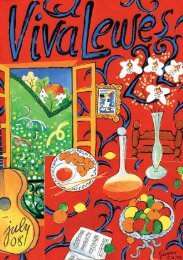You also want an ePaper? Increase the reach of your titles
YUMPU automatically turns print PDFs into web optimized ePapers that Google loves.
IFORD<br />
Half farm, half village<br />
John Robinson looks down at my choice<br />
of footwear, and grimaces slightly. He’s<br />
about to take me on a little tour round<br />
his village, from <strong>the</strong> front yard of his<br />
pink Georgian house. I’m wearing a pair<br />
of black Chelsea boots. He’s wearing<br />
wellies.<br />
As we set off, I ask him how long he’s<br />
been living in I<strong>for</strong>d. He leads me<br />
through a gate, and we squelch our way<br />
across a waterlogged pasture field. “I was<br />
born here,” he replies. “My grandfa<strong>the</strong>r<br />
bought <strong>the</strong> whole place in 1895, give or<br />
take a few houses.”<br />
Joseph ‘JC’ Robinson, a Quaker, purchased<br />
quite a concern, measuring 2,200<br />
acres, stretching from <strong>the</strong> outskirts of<br />
Brighton to <strong>the</strong> Ouse, and employing<br />
over 40 hands, <strong>all</strong> of whom had cottages<br />
on <strong>the</strong> estate.<br />
“I<strong>for</strong>d’s a funny place,” says John. “It’s<br />
a farm which has turned into a village.”<br />
The size of <strong>the</strong> farm hasn’t shrunk since<br />
his grandfa<strong>the</strong>r’s day, but <strong>the</strong> size of<br />
<strong>the</strong> team needed to run it certainly has.<br />
“Now we only have four full time workers,”<br />
he says, unwittingly revealing while<br />
sub-vocalising <strong>the</strong>ir names to count<br />
<strong>the</strong>m, that half of <strong>the</strong>m are c<strong>all</strong>ed Brian.<br />
“Such is <strong>the</strong> way farming has gone.”<br />
Which leaves a lot of <strong>for</strong>mer workers’ cottages freed up <strong>for</strong> rent and<br />
sale. As we walk along <strong>the</strong> loop of a road <strong>the</strong> village is built around,<br />
John tells me what’s become of <strong>the</strong>m: “we rent that one; we sold<br />
that one; that’s still one of ours.” Many of <strong>the</strong> buildings we pass are<br />
still used <strong>for</strong> farming: <strong>the</strong>re’s a grain store, several barns, a yard <strong>for</strong><br />
tractors, a cowshed full of hay-munching cattle, and so on. O<strong>the</strong>rs,<br />
standing in between <strong>the</strong>m, are residential houses, with TV aerials,<br />
well-kempt lawns, and cars parked neatly outside. The most surreal<br />
apparition is a buzzing open-plan mortgage brokers’ office built in<br />
what used to be <strong>the</strong> milking sheds, with ten to fifteen young people<br />
working inside at <strong>the</strong>ir computers, who would have looked more in<br />
place in Hoxton Square.<br />
There are plenty more surprises along <strong>the</strong> way, as John warms to<br />
<strong>the</strong> task of showing me <strong>the</strong> village’s idiosyncrasies. A splendid row of<br />
healthy elms, <strong>the</strong>ir leaves a patchwork of yellow and green; a plaque<br />
announcing that <strong>the</strong> Greenwich Meridian runs through <strong>the</strong> village;<br />
what was once a Victorian boating lake, covered in a lime green carpet<br />
of floating weed.<br />
I haven’t been to I<strong>for</strong>d since <strong>the</strong> early eighties, when I hurdled a<br />
number of rites of passage during <strong>the</strong> teenage parties which were <strong>all</strong><br />
<strong>the</strong> rage in that era in <strong>the</strong> village h<strong>all</strong>, built by John’s grandfa<strong>the</strong>r in<br />
1931. I’m sad to find it’s locked when we get <strong>the</strong>re, but a chap arrives<br />
on cue with a key, so we explore its interior, which brings back a host<br />
of hazy memories.<br />
And fin<strong>all</strong>y to <strong>the</strong> jewel in <strong>the</strong> village’s crown, its Norman church.<br />
Again it seems to be locked; again someone breathlessly arrives, as if<br />
by magic, with a key, which is ancient and iron and as big as a tablespoon.<br />
There’s a graceful Romanesque arch announcing what might<br />
generously be described as a transept; <strong>the</strong> interior is almost <strong>all</strong> nave,<br />
well lit through tiny stained-glass windows. A beautiful place which<br />
demands we speak in a reverential hush.<br />
The church, of course, is surrounded by a lush graveyard, where a<br />
number of John’s relatives are buried, and where he, he tells me,<br />
is glad to know he will finish up. Then he takes me to a flint w<strong>all</strong><br />
overlooking <strong>the</strong> Ouse V<strong>all</strong>ey, and announces something alarming.<br />
“There is a government agency plan to demolish <strong>the</strong> western bank<br />
of <strong>the</strong> lower Ouse, <strong>all</strong>owing it to flood into <strong>the</strong> v<strong>all</strong>ey,” he says. “This<br />
would turn <strong>the</strong> whole area in front of us into a tidal salt marsh, which<br />
would, at high tide, probably reach this w<strong>all</strong>.” He would lose a third<br />
of his farm. There’s little he can do apart from hope <strong>the</strong>y change<br />
<strong>the</strong>ir mind.<br />
I<strong>for</strong>d-on-sea? It wouldn’t be <strong>the</strong> first time. John tells me that <strong>the</strong> remains<br />
of fishing vessels have been found near <strong>the</strong> church, and in <strong>the</strong><br />
Domesday Book <strong>the</strong> annual food production output of <strong>the</strong> village<br />
included ‘16,000s of herrings’. With that strange thought in mind<br />
we trudge back to his house. He invites me in, to look at some old<br />
photographs, and gently reminds me to leave my sodden, muddy, illchosen,<br />
elastic-sided boots outside <strong>the</strong> door. V Alex Leith<br />
W W W. V i V a L E W E s . C o M<br />
V i V a V i L L a g E s<br />
6 1



